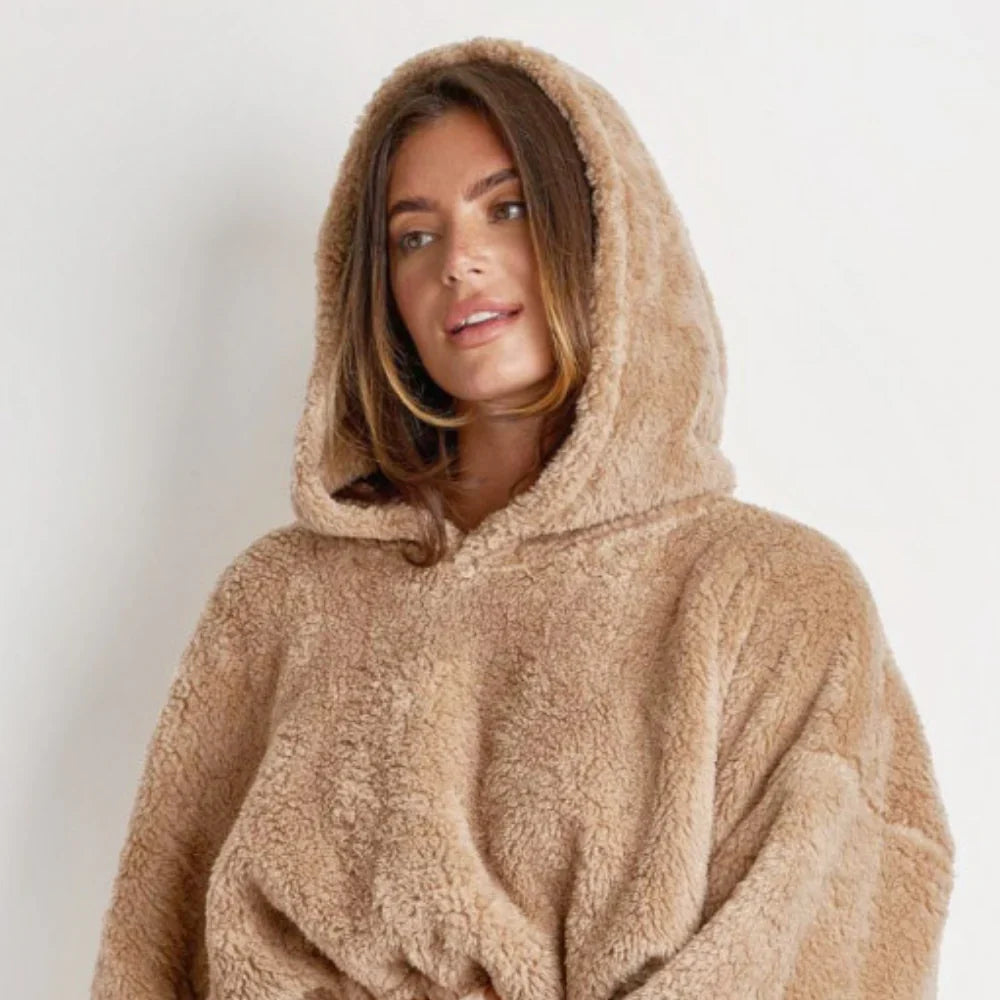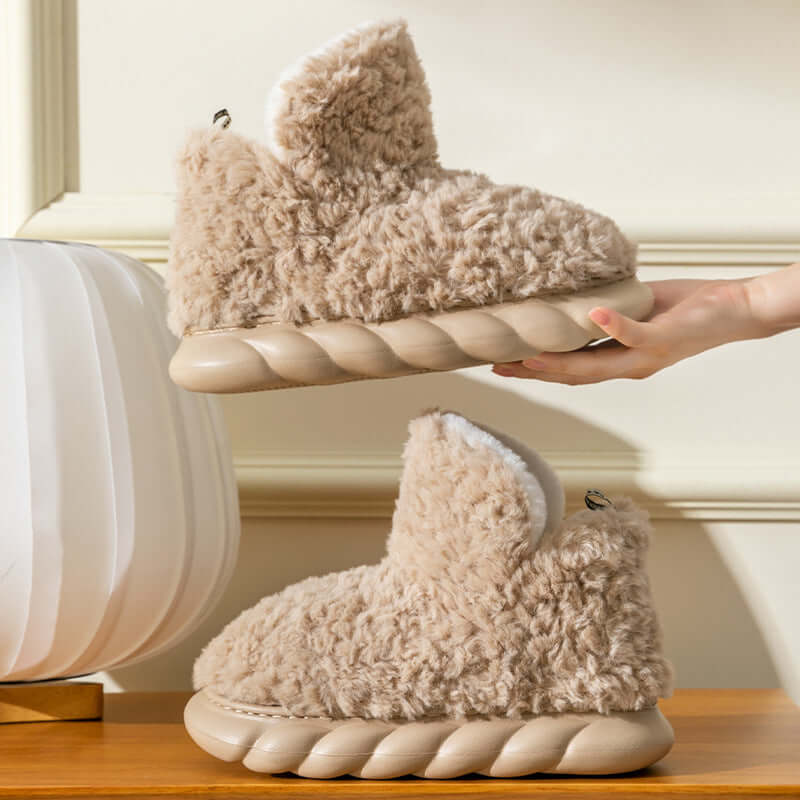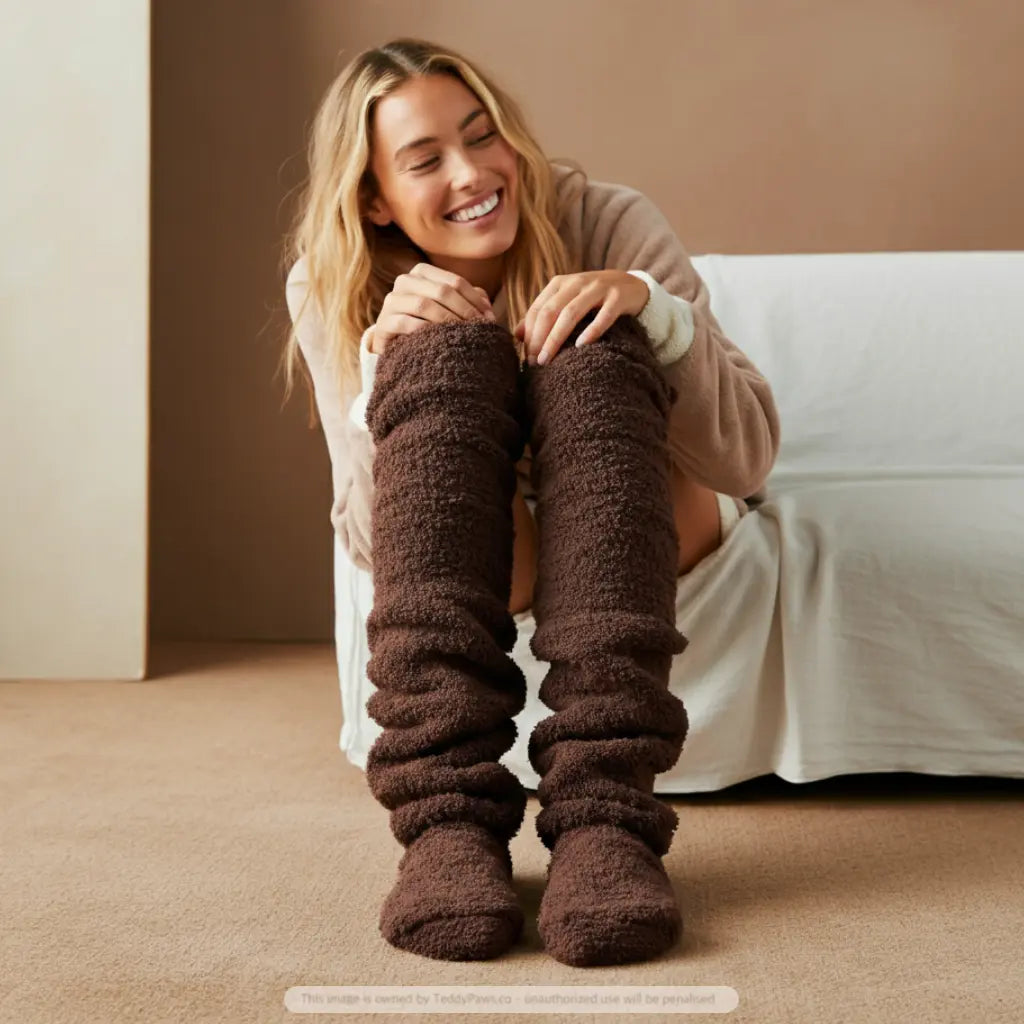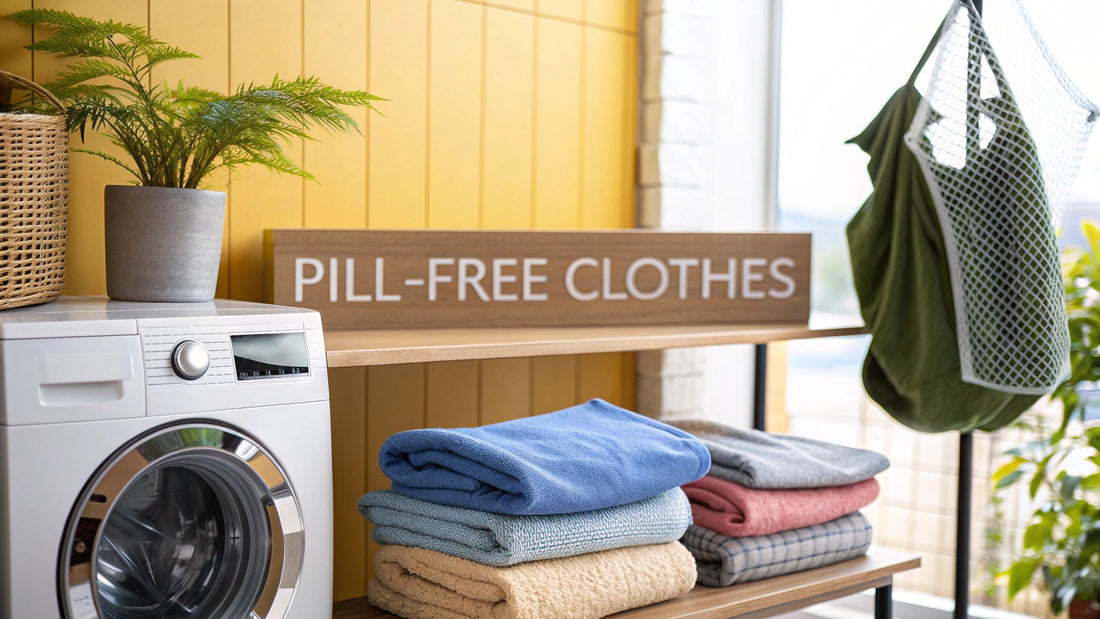
Stop Pilling Now: Keep Your Clothes Looking Brand New
Share
Tired of those infuriating fuzzballs ruining your favorite sweater? The fix is a powerful two-part strategy you can start today. First, become a smarter shopper who can spot quality. Second, overhaul your laundry routine to protect your clothes from damage.
Choosing fabrics with a tight, strong weave—like denim or high-quality Pima cotton—over loose, cheap knits is your first line of defense. Then, when it’s time to wash, you must turn vulnerable items inside out and use a cold, gentle cycle. These two simple actions will immediately slash the friction that causes pilling.
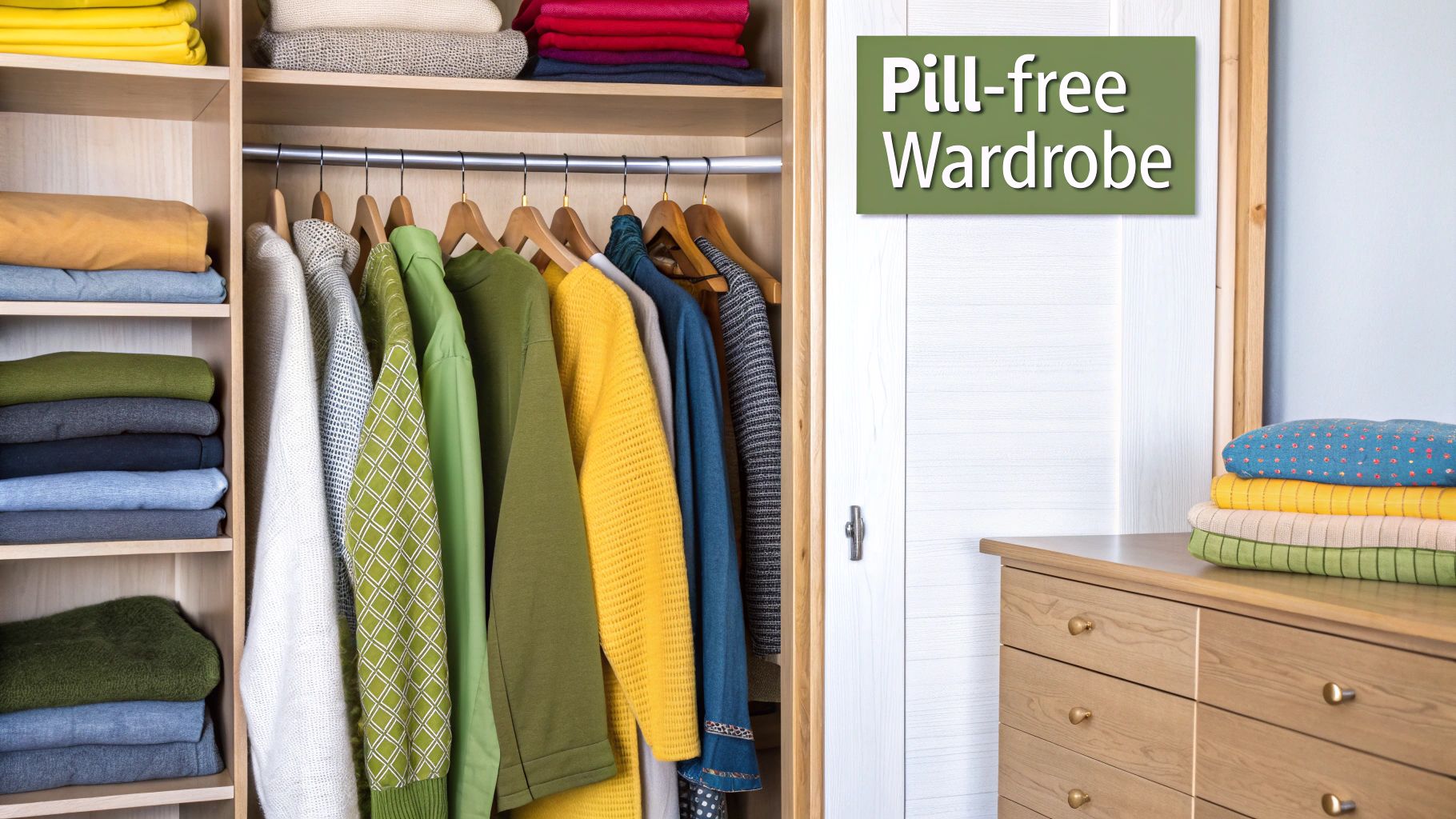
Your Guide to a Pill-Free Wardrobe
Spotting those tiny fuzzballs on your favorite knitwear is more than just annoying—it’s a warning sign your clothes are aging prematurely. Pilling is caused by one thing: friction. It happens when you wear your clothes and when you wash them. As the fabric rubs, fibers break, tangle up, and form those little balls that make a new garment look old before its time.
The good news? This is a problem you can take control of right now.
This guide gives you the exact strategies you need to protect your wardrobe, from simple laundry day hacks to making smarter purchasing decisions. Put these tips into practice, and your clothes will stay looking fresh for years, not just a few wears.
Why Preventing Pilling Matters Now
Beyond aesthetics, preventing pilling is a direct investment in your wardrobe's future. When you shield your fabrics from this damage, you:
- Extend the Life of Your Garments: Your clothes will keep that smooth, like-new finish for much, much longer.
- Save Money: Stop replacing your favorite pieces constantly. This is a direct win for your wallet, starting today.
- Enhance Comfort: This is crucial for the items you live in. When you find the perfect comfy clothes for home, keeping the fabric smooth is essential for it to feel great against your skin.
By mastering a few simple techniques, you can transform laundry day from a fabric-damaging chore into a powerful preservation routine. It’s the easiest way to ensure your favorite cozy pieces stay that way. Don't wait for your clothes to degrade—act now.
So, Why Are Your Clothes Pilling in the First Place?
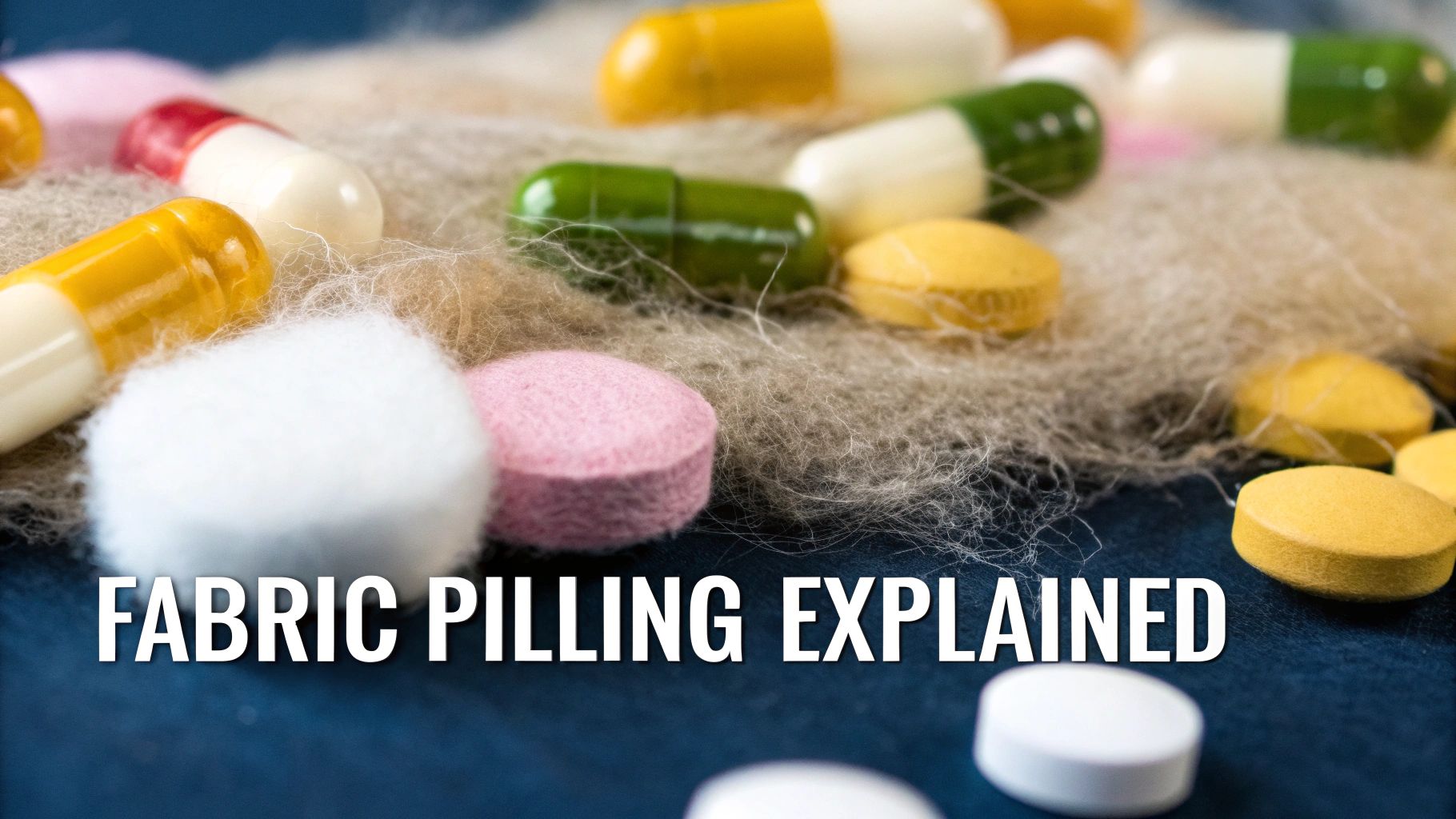
Before you can win the war on fuzzballs, you have to understand the enemy. Pilling isn't bad luck—it's the direct result of friction.
When the fibers in your clothes rub against themselves or another surface, they break and tangle. Eventually, they knot into those tiny, frustrating balls we all hate.
This is exactly why you see pilling in high-friction areas first: under the arms of your favorite sweater, between the thighs of your comfiest sweatpants, or where a seatbelt rubs your shirt. The more agitation a garment endures, the faster it will pill.
Not All Fabrics Are Created Equal
The truth is, a garment's fate is sealed before you even buy it. It all comes down to the fabric. Some materials are practically designed to pill, based on two key factors: fiber length and weave tightness.
- Short vs. Long Fibers: Fabrics made with short fibers (like cheap cotton, polyester, and acrylic) have millions of tiny ends ready to pop out and tangle. In contrast, materials with long, smooth fibers—think silk or premium Pima cotton—are far more resilient.
- Loose vs. Tight Weaves: A loose, airy knit gives a sweater that soft, cozy feel. But that same looseness allows fibers to move, break, and pill. Tightly woven fabrics like denim lock their fibers down, making them incredibly resistant to pilling.
This explains why that cheap, blended-fabric hoodie looks worn out after just a few washes. Its short, loose fibers are a ticking time bomb. Meanwhile, a quality wool sweater, with its long, strong fibers, can look brand new for years if you treat it right.
A fabric's construction is the single biggest predictor of its lifespan. Investing in garments with tighter weaves and longer fibers isn't just about looks—it's a smart, money-saving strategy to build a wardrobe that lasts.
Studies show that fast-fashion garments, often made from loosely spun or blended fibers, are up to three times more likely to pill within a year. A typical polyester-cotton blend t-shirt can show visible pilling after just 20-30 washes. Don't get stuck in that cycle. Learning from sources that provide insights on fashion waste can be a real eye-opener.
Once you know what to look for, you can spot these high-risk items before you buy, saving yourself future frustration and money.
Mastering Your Laundry Routine to Prevent Pilling
Your washing machine can be your clothes' best friend or worst enemy. All that tumbling and friction is a perfect recipe for fuzzballs. But with a few simple tweaks, you can turn laundry day into a preservation process that keeps your favorite pieces looking brand new.
The easiest win? Turn your clothes inside out before they go in the machine. This is non-negotiable. It’s a tiny step that shields the visible side of your garments from the worst of the agitation.
For delicate items or anything prone to snagging, you need to use a mesh laundry bag. Think of it as a personal bodyguard for your clothes, creating a buffer against rougher fabrics like denim or aggressive zippers.
Fine-Tuning Your Washer Settings
Now, let's get serious about your machine's settings. Always choose the gentle or delicate cycle. These cycles use less agitation and slower spin speeds, which means less stress on your clothing fibers. Cold water is your best ally; hot water weakens fibers, making them prime candidates for pilling.
Another pro tip: switch to a liquid detergent immediately. Powders often fail to dissolve completely in cold water. Those leftover granules act like fine sandpaper rubbing against your clothes, which is exactly what you want to avoid.
Look at the dramatic impact these small changes have.
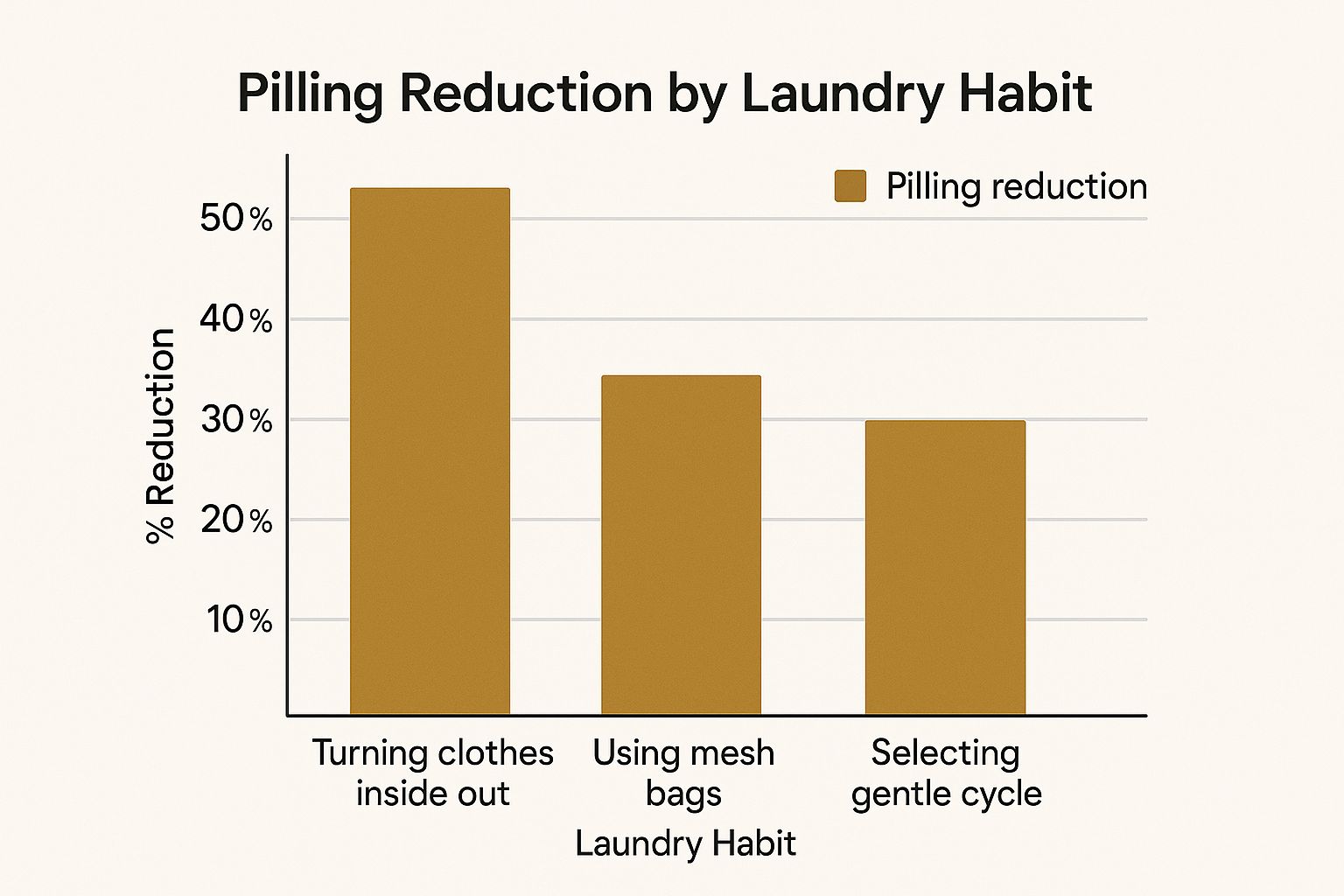
It's undeniable—just turning your clothes inside out can slash pilling by half. That's a huge return for zero effort.
The most overlooked mistake is cramming too much into the washer. Your clothes need room to move. When they're packed tight, they just rub against each other relentlessly, creating a friction-fest that leads directly to pilling. Stop doing this now.
Giving your clothes breathing room is one of the best things you can do. This, along with other common slip-ups, can wear out your wardrobe prematurely. To stop making these costly errors, checking out the 5 Laundry Mistakes You're Probably Making is a great way to protect your clothes.
These habits can even help with other laundry issues, like static cling. If you’re tired of clothes sticking together, learning how to remove static from clothes will keep them soft and separate. Putting these tips into practice today will pay off for years to come, preserving the look and feel of your entire wardrobe.
Making Strategic Fabric Choices When Shopping
The best way to win the war on pilling is to stop it before it starts—right in the store. Becoming a savvy shopper who can identify pill-resistant fabric is your ultimate defense. A quick check of a garment's tag is all it takes to make a smarter, longer-lasting purchase.
Start actively seeking out tightly woven materials. Fabrics like denim, silk, and linen have their fibers locked in place, leaving no room for them to break loose and cause trouble. It's why a great pair of jeans or a quality silk blouse almost never pills; they’re built to withstand daily friction.
Decoding Knits and Synthetics
When hunting for cozy sweaters and loungewear, the magic words are long-staple fibers. Cottons like Pima or Egyptian and wools like Merino have longer, stronger fibers that are far less likely to snap and tangle. They might cost a little more upfront, but they pay for themselves by not turning into a fuzzy mess after a few wears.
Let's be real: the goal is to break the cycle of disposable clothing. Picking a higher-quality fabric isn't just a one-time purchase. It's an investment in a piece that will look and feel fantastic for years, saving you money and hassle in the long run. Don't throw your money away on clothes that won't last.
Also, keep an eye out for clothes made with anti-pilling technology, especially when buying activewear or fleece. The market for these advanced textiles is booming for a reason. Global demand for anti-pilling fleece fabrics is projected to hit US$ 444 million by 2031. These materials are engineered from the ground up to maintain their smooth surface.
To arm you on your next shopping trip, use this cheat sheet. It's your field guide to spotting fabrics that will stay smooth.
Fabric Pilling Resistance Guide
| Fabric Type | Pilling Tendency | Best For |
|---|---|---|
| Merino Wool | Very Low | Sweaters, base layers, socks |
| Denim | Very Low | Jeans, jackets |
| Silk | Very Low | Blouses, dresses, scarves |
| Linen | Low | Shirts, pants, summer dresses |
| Pima/Egyptian Cotton | Low | T-shirts, bedding, loungewear |
| Acrylic | High | Sweaters, blankets (often blended) |
| Polyester | High | Activewear, fleece, blends |
| Rayon | Very High | Dresses, blouses, flowy garments |
This table isn't exhaustive, but it gives you a powerful starting point for making choices you won't regret.
Getting a feel for different materials is a skill that pays off. Spending time understanding different fabric types will give you the confidence to pick pieces truly built to last. This is especially true when you're looking for the softest loungewear for women, where you demand both incredible comfort and durability. Choose smarter from the start, and you'll build a wardrobe designed to look great for the long haul.
How to Safely Remove Pills from Your Clothes
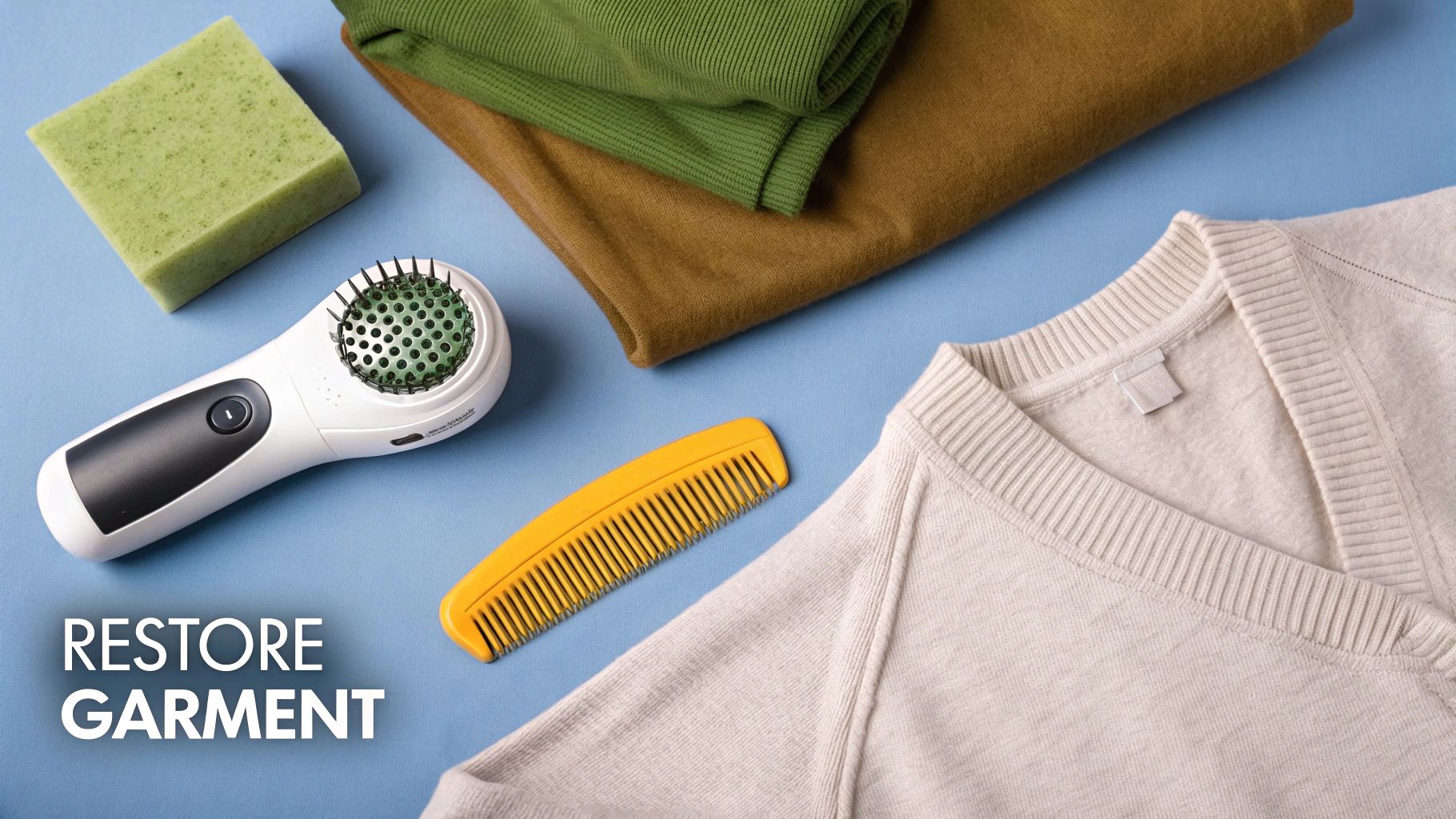
Even with a perfect laundry routine, a few stubborn pills might still appear. But this is your chance to fight back. You can absolutely rescue a favorite garment, transforming it from a closet reject into a piece you're excited to wear again.
The mission is simple: eliminate the pills without damaging the fabric underneath. For that, you have a few essential tools, and picking the right one is critical.
Choosing Your Depilling Tool
The most effective and satisfying solution is an electric fabric shaver. This is a non-negotiable tool for anyone serious about wardrobe maintenance. It glides over the fabric, neatly trimming off pills without pulling or snagging delicate yarns. It's perfect for fine knits and cotton blends that need a gentle touch.
For tougher fabrics like a heavy wool coat, a sweater comb is a fantastic manual option. It's designed to gently lift pills away from the surface of dense knits. A pumice-like sweater stone works similarly but is more abrasive, so save that for your most durable materials only.
Investing in a quality electric fabric shaver isn't just another purchase; it's a commitment to making your clothes last. The first time you bring a tired, pilled sweater back to its original glory, you’ll realize it's one of the best tools you can own for long-term clothing care. Don't wait—get one today.
To use any of these tools safely, always lay your garment on a flat, firm surface. Pull the fabric taut with one hand and gently work the shaver or comb over the pilled areas. Small, circular motions work best. And remember, don't press too hard—let the tool do the work. The transformation is immediate and incredibly rewarding. It's time to stop letting pilling win.
Got Pilling Questions? We've Got Answers
Even when you've mastered your routine, a few tricky questions about pilling always seem to pop up. Let’s get you the answers you need to keep your favorite pieces looking brand new.
Does Hand Washing Stop All Pilling
I get this one a lot. Hand washing is a fantastic move for delicate knits because it dramatically cuts down on machine friction. It’s one of the best preventative actions you can take.
But will it stop pilling completely? No. Remember, pilling also happens from everyday wear. Think of hand washing as your best defense, not an impenetrable shield.
Speaking of laundry myths, let's talk fabric softener. Some people think it causes pilling, but it actually does the opposite. It coats fibers, making them slicker and less prone to friction. Just check your garment's care label first, as it can cause buildup on some high-tech fabrics.
Is it better to air-dry clothes to stop pilling? Absolutely. The intense heat and tumbling action of a dryer is a recipe for fiber damage and pilling. Switching to air-drying is one of the single most effective habits you can adopt to preserve your clothes. Start now.
Are Expensive Clothes Always Pill-Proof
You'd think a higher price tag would guarantee a pill-free life, but that’s not always the case. It’s true that pricier garments often use higher-quality, long-staple fibers and tighter weaves, which are naturally more pill-resistant.
However, a delicate, loose-weave sweater from a high-end designer might be meant to be fragile and can pill easily. The price is less important than the material. Your best bet is to always check the fabric composition—that’s the most reliable clue.
Taking these extra steps is also a win for the environment. Synthetic textiles like polyester and nylon are a huge source of microplastic pollution, responsible for up to 35% of all microplastics in the ocean. A lot of that comes from fibers shedding during a rough wash cycle. If you want to learn more, explore the eye-opening data on fashion industry statistics.
Ready to wrap yourself in cloud-like comfort that's built to last? The ultra-soft, high-quality fabrics at TeddyPaws are specifically designed for lasting coziness and minimal pilling. Don't wait for your current loungewear to wear out. Find your new favorite piece today at https://teddypaws.co.

